Social Media Addiction Statistics: Facts, Stats & Trends in 2025
Social media has become integral to our everyday lives, and so it is crucial to understand how social media addiction works -- its causes, impact on society and treatment options. We’ve compiled some of the best social media addiction statistics addressing these topics and more.
-
04/01/2025 Facts checked
We refreshed the statistics to reflect the most recent available data.
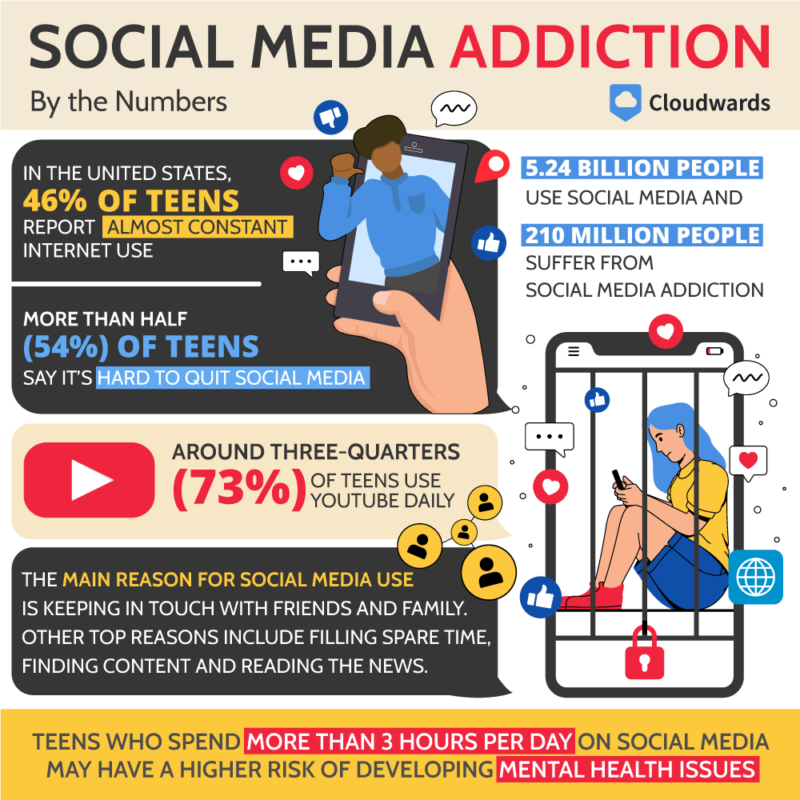
On the surface, social media addiction might seem trivial. However, compounding evidence suggests that this very real addiction can have significant effects on a person’s mental health. In this article, we’ve compiled social media statistics, facts and trends from some of the most reliable sources online.
To understand social media addiction, it’s important to analyze the factors that lead to it, the demographics most affected by it, and how people around the world interact with social media platforms.
Our social media addiction stats provide a comprehensive look at the situation by addressing fundamental questions such as “Who’s using social media?” and “How does social media addiction affect teenagers?”
Besides addiction, several other risks are associated with social media, including phishing, cyberbullying, identity theft and scams. Children and adolescents are the most vulnerable to these risks.
We’ll start with a breakdown of the various social media platforms and how they are used around the world.
Social Media Platforms: Who’s Using Them & How?
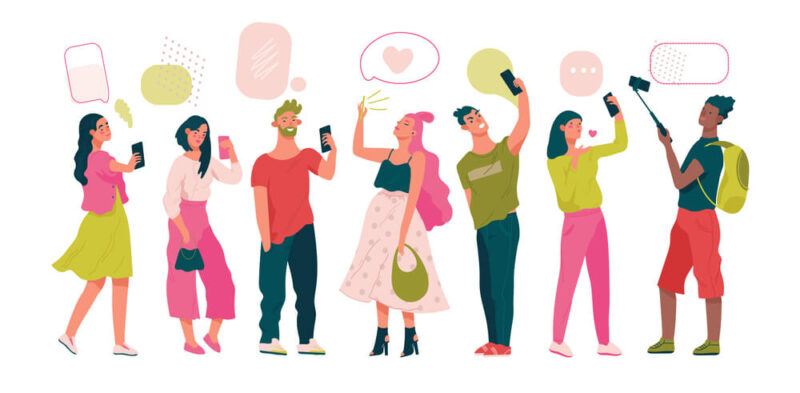
Billions of people of all ages, genders, occupations, ethnicities and geographic locations use social media accounts. Trends show that social media usage increases the younger the population segment is. Unsurprisingly, many individuals say they use social media platforms mainly to connect with others.
1. Top Social Media Platform Use Varies by Age
Americans under 30 are “far more likely” to use social media platforms than older generations, reveals a 2023 Pew Research report.
The report goes on to highlight how Instagram, Snapchat and TikTok are especially popular with under 30s. 78% of people aged 18 to 29 report using Instagram, in comparison to just 15% of those 65 and up. For Snapchat, 18 to 29-year-olds are also the most prevalent users (65%), and young TikTok users total 62%.
By contrast, only 4% of older adults (65 and over) report using Snapchat and 10% report using TikTok.1
2. Most People Use Social Media to Stay Connected
A 2024 report mentions staying in touch with family and friends as the “top reason” for going on social media. This reason got the highest percentage across all surveyed groups, especially Baby Boomers (59%.)
In addition, 56% of Generation Alpha folk and 45% of Generation Z respondents chose keeping in contact with loved ones as their main reason, as did 47% of millennials and 55% of those in the Generation X category.
That said, Generation Z also picked “filling spare time” as the joint main reason.2
People Who Use Social Media to Stay in Touch with Loved Ones
Gen Alpha: 56%
Gen Z: 45%
Millennials: 47%
Gen X: 55%
Baby Boomers: 59%
3. Facebook Still Has the Most Users
As of February 2025, Facebook is the social media platforms with the most users: around 3.7 billion worldwide. The second biggest social media platform is YouTube with over 2.5 billion users across the globe.
The report also shows that Instagram and WhatsApp are the third and fourth biggest social media platforms, respectively, with each having about 2 billion users.3
4. Short-Form Videos Offer High ROI
People also use social media for marketing and advertising purposes. A study by HubSpot found that 90% of marketers highlight short-form content on platforms like Instagram and TikTok as having a high or at least average return on investment (ROI).4
How Social Media Usage is Changing
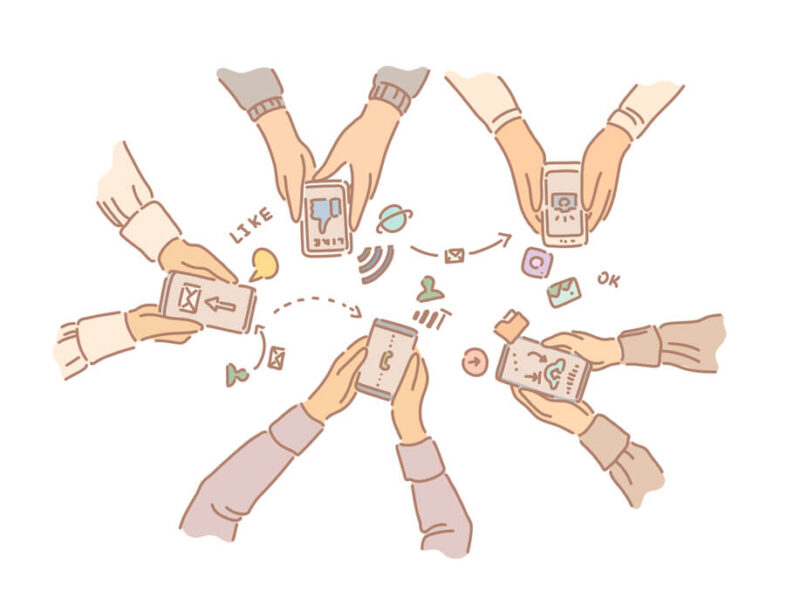
Social media usage patterns are always changing. These statistics show how social media trends have shifted over the years.
5. Not Much Change in the Time Spent on Social Media
The average person spends two hours and 20 minutes on social media daily. This represents a three-minute drop from 2020.5
6. Short-Form Content’s Influence Is Growing
There’s no denying that short-form videos have become one of the most popular forms of content in recent years. In 2024, it was reported that approximately 81% of those surveyed favor short-form content from brands.
The same report explains that people are “most likely” to watch brands’ short-form content (from 15 to 60 seconds long) on platforms like TikTok and Instagram. 6
7. Social Media Use Continues to Grow Rapidly
As social creatures, humans are wired to process social information at a high level, and we thrive on connection. Social media has capitalized on this inclination to grow at breakneck speed.
Today, there are around 5.24 billion social media users globally — that’s 63.9% of people. This represents a 4.1% increase over a period of one year.7
8. Social Media Is Dynamic
Social media popularity is always shifting. Despite having the most users, one survey found that all age groups are engaging with Facebook less these days; 25 to 34-year-olds lead the way with 35% saying they’ve “significantly” reduced Facebook use.
On the other hand, a solid 45% of the 55 to 65-year-old group said their Facebook use hasn’t changed.8
The Prevalence of Social Media Addiction

According to Healthline, “Addiction is a chronic dysfunction of the brain that involves reward, motivation and memory. It’s about the way your body craves a substance or behavior, especially if it causes a compulsive or obsessive pursuit of ‘reward’ and lack of concern over consequences.”17
Experts estimate that millions of Americans are addicted to social media apps, with the younger generation being more susceptible to social media addiction.
9. Millions of People Worldwide Are Addicted to Social Media
According to a study by the University of Michigan, the number of people who suffer from social media addiction worldwide is estimated to be about 210 million. As for Americans, California State University has found that about 10% are estimated to be addicted.9
Percentage of Addiction Among Worldwide Social Media Users
10. Many Use Social Media to “Fill Spare Time”
While keeping in contact with friends and family is the primary reason people use social media, “filling spare time” is another big reason for generations older than Generation Alpha. For Generation Z (45%), it’s the main reason (along with keeping in touch with loved ones).
38% of Millennials and Generation X respondents also report using social media as a way to fill spare time, as do 33% of Baby Boomers.2
How Teens Use Social Media
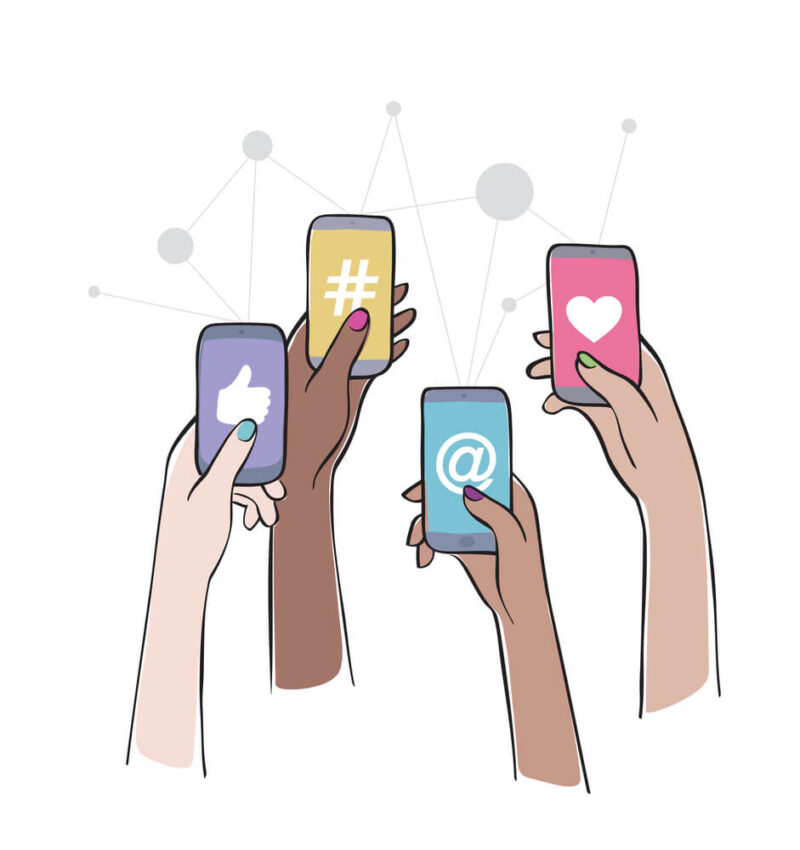
and TikTok (63%), followed by Instagram and Snapchat.
Social media has become integral to the lives of many teenagers, but its impacts on growing up are still uncertain. To understand how social media affects teenagers, it’s essential to understand how they use it and what they use it for.
In this section, we’ll explore the different ways in which social media affects teenagers and their relationship to the world. Here are the stats showing how teenagers use social media.
In this section, we’ll explore the different ways in which social media affects teenagers and their relationship to the world. Here are the stats showing how teenagers use social media.
11. A Large Percentage Use YouTube Daily
According to a Pew Research survey of teens aged 13 to 17, about 73% of teens use YouTube daily. 15% of this number is made up of teens who say their use is “almost constant.”
Six-in-ten go on TikTok just as frequently, with 16% of this figure reporting using it “almost constantly.” About half of teens surveyed say they use Instagram (50%) or Snapchat (48%) at least once a day, while 20% claim daily use of Facebook.10
Daily Use by Platform
YouTube: 73%
TikTok: 57%
Instagram: 50 %
Snapchat: 48%
Facebook: 20%
12. Usage Varies By Race, Ethnicity & Age
A report published by Pew Research breaks down the prevalence of social media addiction among young Americans across several demographics, including age, race and ethnicity.
The report indicates that 79% of Black teens and 74% of Hispanic teens use TikTok compared to 54% of White teenagers. A larger percentage of Black and Hispanic teens also say they use X and Instagram.
As for age groups, those aged 15 to 17 reported higher usage of social media platforms. While 72% of teens in this age group report using Instagram, a much lower 43% of 13 to 14-year-olds do. Likewise, 63% of the older teen age group say they use Snapchat compared to 44% of the younger group.10
13. A Majority of US Teens Post About Their Accomplishments
Roughly 43% of U.S. teens say their social media posts are about their accomplishments, 34% say their posts are about their family and 25% share posts about their emotions and feelings, according to the 2022 Pew Research Center study. Only one in 10 teens report posting about their dating life, personal issues or their political and religious beliefs.11
14. Teen Girls Prefer Instagram and TikTok
There are stark differences in the way teens use social media. The Pew survey conducted on U.S. teens shows that teen boys are more likely to use YouTube (93% vs 87%), while more teen girls use Instagram (66% vs 56%) and TikTok (66% vs 59%).
On the other hand, Facebook use is pretty much the same (31% for boys and 32% for girls) or very similar.10
15. YouTube Is the Most Popular Social Media Platform for Teens
Of those surveyed by Pew Research, nine out of ten 13 to 17-year-olds say they’re YouTube users.
Social media platform preferences for teens have shifted over the years. While YouTube is currently the most-used social media platform by teens, the number — 90% — has decreased from 95% in 2022.
TikTok is the second most popular, with 63% of teens using it, followed by Instagram (61%) and Snapchat (55%). Only 14% use Reddit, and 17% use X.10
Most Popular Social Media Platforms for U.S. Teens
YouTube: 90%
TikTok: 63%
Instagram: 61%
Snapchat: 55%
How Social Media Affects Teens
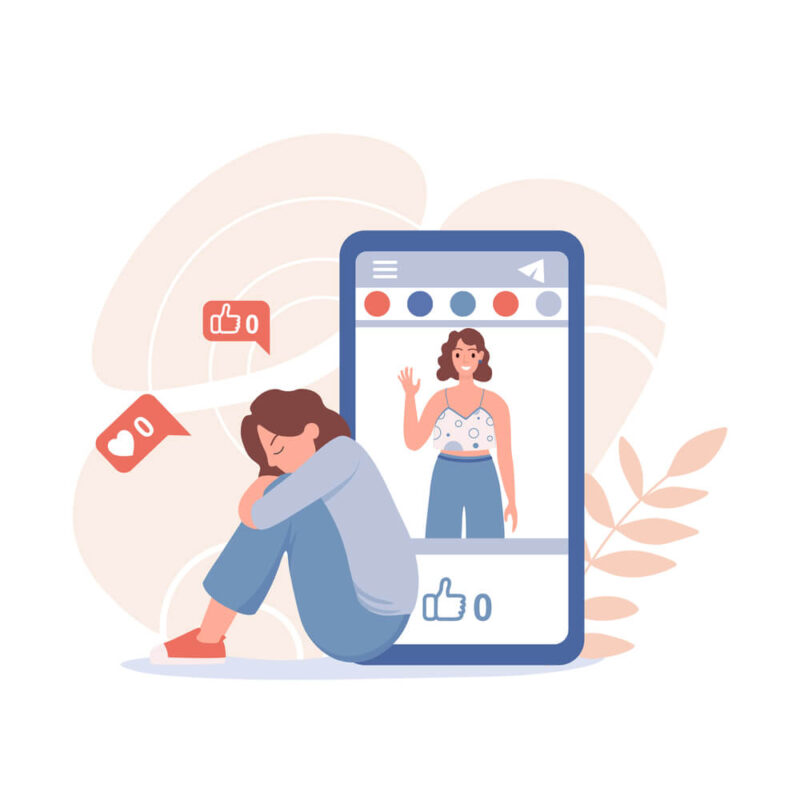
Social media affects the behavior of teens in different ways. Here are the stats showing how social media can affect teens.
16. Most Teens Are Concerned About What They Post on Social Media
Around 40% of American teens — particularly teenage girls — avoid posting certain things on social media due to the fear of embarrassment, according to a 2023 study conducted by Pew Research Center.
In the same study, about 38% of teens said they avoid posting things on social media that deviate from how they like to present themselves, while 27% cited the fear of jeopardizing future academic or career opportunities as their reason for not posting.12
17. Almost Half of Teens Are Online Constantly
Almost half (46%) of surveyed teenagers (Pew Research) report being online “almost constantly.” This is a big leap considering 24% of teens said the same thing ten years prior to the 2024 survey. The survey also reveals that 96% of teens go online every day.10
Percentage of Teens Online “Almost Constantly”
18. There’s a Correlation Between Time Spent on Social Media and Mental Health
A 2019 study published in the Journal of American Medical Association (JAMA) found that teens who spend more than three hours per day on social media may have a higher risk of developing mental health issues.13
Social Media Addiction: Causes and Symptoms

Unfortunately, social media addiction can occur due to several mental health issues, including anxiety, depression and low self-esteem.
In addition, many people with social media addiction struggle with impulse control, finding themselves automatically checking apps without conscious decision, indicating how deeply ingrained these behaviors can become.
There’s also reason to believe that addictive behavior could stem from the way social media platforms are designed.
19. Social Media Creators Benefit From Addictive Behavior
Social media algorithms are specifically designed to maximize engagement by showing content that triggers emotional responses, potentially increasing addictive usage patterns. A research paper explains how reward systems built into social media platforms create a “dopamine-driven feedback loop,” increasing the likelihood of behaviors like “obsessive checking” and “habitual interaction.”
These behaviors end up being lucrative for the platforms, the researchers explain, but can come at a heavy price for those stuck in the cycle. Potential mental health issues cited as a result of regular social media use include anxiety and depression.14
20. Peer Pressure Fuels Social Media Addiction
Peer pressure and social comparison are also contributing factors. Teenagers crave a sense of belonging, and determination to fit in can result in them spending more time on social media.
This becomes a “vicious cycle,” say researchers, as this means teens are more likely to start comparing themselves and their lives to those of others, leading to possible “feelings of inadequacy.”14
Fear Of Missing Out (FOMO) is a significant psychological driver behind social media addiction, with many users constantly checking platforms to avoid missing important updates or social events.15
21. Social Media Addiction Has a Range of Behavioral Symptoms
According to GoodRX, social media addiction can manifest as a range of behavioral symptoms. A person addicted to social media may spend excessive amounts of time on social media. They may find themselves getting distracted by social media when doing other activities or hobbies.
Social media addiction also has a significant impact on social life. A person addicted to social media may limit socializing to use social media.
Social media addiction can also cause one to feel irritable or anxious when they can’t use social media platforms. People who are addicted to social media use social media platforms to distract themselves from unwanted emotions.16
How to Treat Social Media Addiction
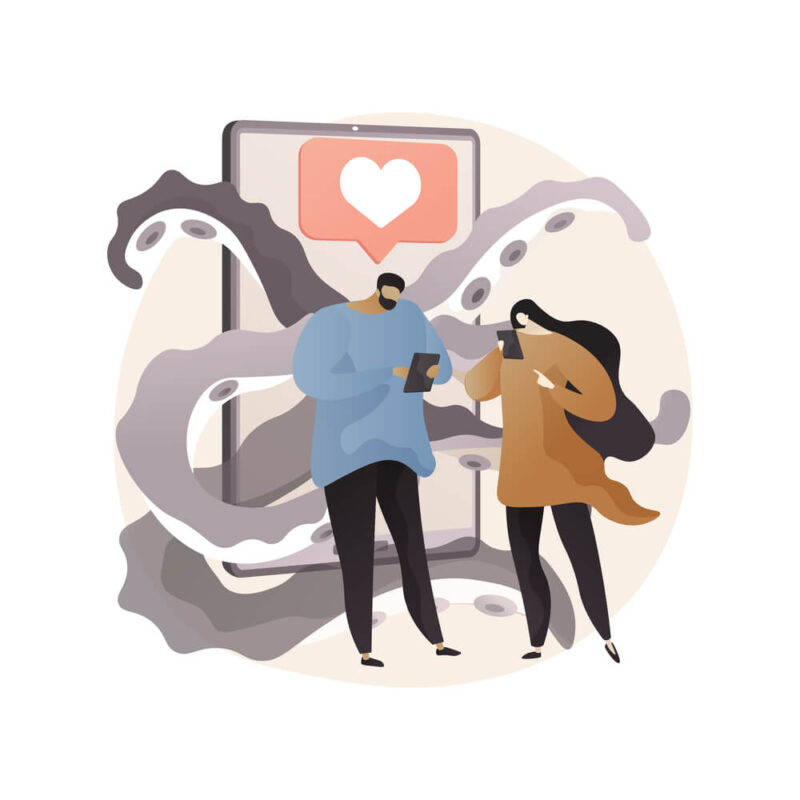
try a digital detox or setting healthy habits.
You can quell excessive social media use in a number of ways. One way is to undergo a social media detox or cleanse. This requires deleting social media apps, muting notifications for a designated number of days, or limiting time spent checking social media feeds.
What’s more, it may help to undergo a complete digital detox for a while. Completely disconnecting from all electronic devices, not just social media platforms, may make it easier to break the cycle.
Maintaining digital wellbeing requires conscious effort to balance online engagement with offline experiences, which is essential for preventing and recovering from social media addiction. You can fill up your schedule with new hobbies and activities in place of social media use. This can help quell the urge to check social media while helping you incorporate new habits into your routine.
Sometimes social media addiction can be difficult to break without the help of a professional. Seeing a professional can help provide you with the emotional support you need and empower you with tools to address the addiction. Many therapists and psychologists are happy to treat social media addiction as a serious problem.
Other Considerations: Curbing Social Media Addiction
- Cognitive Behavioral Therapy (CBT) has proven effective for treating social media addiction by helping people identify triggers, change negative thought patterns and develop healthier digital habits.
- Many devices now offer screen time limits and usage tracking features that can help users monitor and restrict their social media consumption to healthier levels.
- Practicing digital minimalism by intentionally reducing the number of platforms used and removing non-essential apps can help create a healthier relationship with technology.
Final Thoughts: Social Media Addiction Statistics
Social media addiction is a problem that will continue as long as social media platforms play a role in our society. You can reduce your chances of getting addicted to social media by understanding how it impacts your mental health, limiting your usage and seeking professional help if necessary.
We hope our statistics have provided you with insights into social media addiction. Have you ever been addicted to social media? Do you know anyone who is addicted to social media? What steps have you taken to find help for yourself or them? Let us know in the comments section below, and as always, thanks for reading.
FAQ: Social Media Addiction Facts, Stats & Trends
Sources:
- Pew Research Center: Americans’ Social Media Use
- GWI: The Ultimate Social Media Trends Report 2024
- Statista: Most Popular Social Media Networks Worldwide (Feb 2025)
- HubSpot: Social Media Trends Report
- GWI: Social Media Trends 2024
- Sproutsocial: 2024 Content Benchmarks Report
- DataReportal: Digital 2025: Global Overview Report
- ExpressVPN: Survey: Is Facebook Still Relevant in 2025
- Addiction Help: Social Media Addiction Statistics
- Pew Research Center: Teens, Social Media & Technology 2024
- Pew Research Center: What Teens Post on Social Media
- Pew Research Center: Teens and Social Media: Key Findings from Pew Research Center Surveys
- Jama Network: Associations Between Time Spent Using Social Media and Internalizing and Externalizing Problems Among US Youth
- PubMed Central: Understanding Social Media Addiction: A Deep Dive
- Plos One: Quality of Life and Mental Health of Adolescents
- GoodRx: Social Media Addiction: Could Your Scrolling Habits Be a Problem?
- Healthline: An Overview of Addiction


